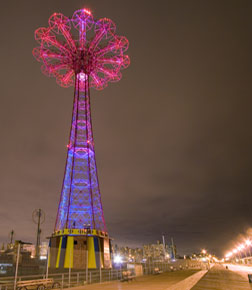After a seven-year effort to restore and illuminate Coney Island�s historic Parachute Jump, the landmark is now a beacon in the Brooklyn skyline simultaneously representing a bygone era and the area�s future redevelopment. The $5-million project involved not just some high-tech illumination, but also extensive structural renovations.
 |
| Steel and LEDs give new life to ride idled since 1969. (Photo courtesy of Arch Photo Inc.) |
Engineering firm STV Inc., New York City, renovated the 67-year-old ride's steel-lattice tower, which had been deteriorating in the salty air since the ride closed in 1969. After a thorough inspection, STV concluded that the structure required replacement of several steel beams in order to reinforce it. The $2.7-million renovation also involved removing lead paint, a task that proved more difficult than anticipated.
STV planned to remove the paint by enclosing the 260-ft tower with a tarp and sandblasting, which created a structural challenge for engineers. Albert Thompson, project manager and assistant chief structural engineer, STV, says wind would blow through the open structure creating a sail effect with the tarp, potentially causing the tower to collapse. Wind would have caught the surface area and created a large overturning force, he adds. The deadweight of the foundation system and base concrete slab anchor bolted to the 170-ton tower would not be able to resist the lateral-blowing wind. "We decided to take down the tower in sections so would could be done at ground level and we wouldn't have to worry about the sail," Thompson says.
Two large cranes dismantled the tower in 40-ft sections allowing workers to remove paint, make structural repairs and repaint more effectively. Thompson says city officials initially balked at that approach. "We had calculations and procedures showing that nothing else would work," he says. "It took time for them to realize we weren�t crazy for taking it apart."
To showcase the tower's revitalization, the city spent $1.7 million to illuminate it for the first time. STV tapped New York City-based Leni Schwendinger Light Projects Ltd. to design the lighting concept. Schwendinger says she designed 6 animated design scenarios that change over time with a tight color pallet. "I had over 16 million colors to choose from," she says. "The scenarios are very dynamic from second to second."
The color scenarios are used during different seasons, holidays, and tide cycles. There is also a patriotic color scenario. Sparkling LED lights, 450 in all, illuminate the tower, and 17 automated color-changing floodlights located at four points along the base highlight specific sections, Schwendinger says. To pay tribute to the ride's history, ring-shaped sparkle lights encompass the tower in sequences to evoke the rise and fall of parachutes. Schwendinger used computer control sequencing to create that effect.
Schwendinger says the mission of Light Projects Ltd. is to "create wondrous spaces with light." A majority of the small boutique firm's work is completed in public gathering spaces such as parks and streetscapes. The certified women-owned firm has an interdisciplinary staff of six individuals who are currently working on 30 projects around the world.
Schwendinger says the Parachute Jump was an ideal project because it brought together elements of communication, innovation, and collaboration with community stakeholders and engineers. "I enjoy working with engineers because they can help us create the infrastructure for innovative projects," she says. "We like to do parallel engineering, which is both creative and practical."
To ensure that collaboration runs smoothly, Schwendinger recommends that lighting designers become involved in a project during the beginning stages. "Creative lighting designers should be brought on early to establish ideas and concepts so the plans take advantage of the lighting," she says. "Then bring them back once there is a framework to work with."

Post a comment to this article
Report Abusive Comment